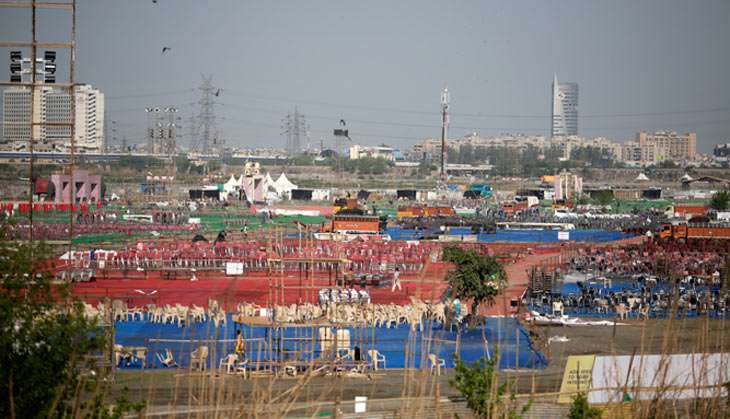Art of Living 'destroyed' Yamuna floodplains, 10 years needed to restore

Art of Living Foundation's (AOLF) World Cultural Festival, held in March 2016, has "not just damaged", but "completely destroyed" the Yamuna floodplains, a seven-member expert committee appointed by the National Green Tribunal (NGT) has said.
The panel has submitted a report, stating that the festival caused irreversible losses to the biodiversity and soil quality of the floodplains.
"Most of the ecosystem functions of natural wetlands have been completely lost," the report states, adding that at least 10 years of monitoring will be required to fully restore the floodplains.
The much-awaited report, for the first time, establishes the nature and extent of the changes to the Yamuna floodplains caused by the Art of Living event, and paves the way for future action against it.
Also read- Mega stench after mega show: smell of urine and garbage abound on Yamuna bank
What is this committee?
The panel in question is the NGT principal committee on the Yamuna floodplains. It is the same committee that had said in March that the AOLF event had caused damage worth about Rs 120 crore to the floodplains. However, that was a rough figure based on an interim observation - this is its final report.
It was asked in February 2016 to study if, and how, the AOLF festival affected the floodplain ecology, after the festival was challenged before the NGT by environmentalists. The case is still being heard.
The panel is chaired by Shashi Shekhar, the present secretary of the Ministry of Water Resources, River Development and Ganga Rejuvenation. Its members are Prof AK Gosain (IIT Delhi), Prof CR Babu (Delhi University), Dr Brij Gopal (ecologist), Dr Nitin K Labhateswar (scientist, NEERI), Prof AA Kazmi (IIT Roorkee) and RM Liberhan (former bureaucrat).
Also read- NGT committee member CR Babu disagrees with approval given to AOL event
Why is its report important?
This is the first official assessment of the damage caused by AOLF's festival. Based on its interim observations, AOLF had been fined Rs 5 crore as an interim environmental compensation.
The final report now has to potential to increase this amount. What the amount is will be finalised based on calculating the costs of restoration, which the committee has been asked to complete in about two months.
Also read- Art of Living pays Rs 5 crore fine imposed by NGT, tries to save face
The committee submitted its report on 28 July. A copy of the report was provided recently to the petitioners, and has been reviewed by Catch. The petitioners, and Art of Living, have three weeks to file their responses to the report.
Here's what the report says:
1. Change to the river's channel
The report says there are "physical changes" to the Yamuna's channel. This, it says, is because of the construction of roads and pontoon bridges, removal of riparian vegetation and because the river's side channel was blocked. The flattening of the floodplains has eliminated the "diversity of habitats", including water bodies. This has reduced floodwater retention and the ability to support a variety of flora and fauna.
2. Biodiversity destroyed
Contrary to Art of Living's arguments that no trees were cut, the report states that "almost all" of the floodplain's vegetation has been lost, from trees to microscopic algae. "Their total loss cannot be readily visualised and documented," the report says.
It adds that since the vegetation was food for small organisms, they were "rendered homeless" and "consigned to their graves under the debris".
The committee says this is an "invisible loss of biodiversity" that can't be assessed, and "may never be able to return".
3. Soil compressed
Compaction of soil - or the way it was pressed down by the stage, guests, transport vehicles, etc - has reduced its ability to absorb water and naturally harvest rainwater. It prevents oxygen from going below the surface, choking insects and microorganisms.
Toxic substances from waste disposed at the site will affect quality of soil and water in the river.
4. Loss to humans
Loss to soil, vegetation and organisms has meant a loss of benefits to people, the report says. Loss of vegetation reduces the conversion of carbon dioxide to oxygen. Some of the plants also purified the water by absorbing organic wastes.
5. Monsoon woes
The committee has said that monsoon rainwater has already caused some damage, complicating and delaying restoration efforts. This includes leaching of toxic substances into the river, and arrival of undesirable species.
6. Restoration measures
The committee says that the restoration of the event venue will be quite different from other floodplains of the Yamuna, and, in fact, require "several times more" effort and money.
It recommends various measures. First, the soil will need to be loosened. It will have to be dredged, and debris and external material buried for making the roads will have to be removed.
Second, ramps leading to the site will have to be removed. The side channel will have to be cleared of all blockages.
Third, the soil will have to be detoxified and native species of vegetation planted. Fauna, including water- and soil-dwelling organisms and microbes, will have to be restored "after careful investigation, culture and introduction".
7. Re-planning the floodplains
The committee has taken a long-term view. It has told the NGT that the entire floodplain area has to be replanned, to restore water bodies and natural physical features.
Regarding the case at hand, it has said that the entire restoration itself will take at least a decade. It has said that a Detailed Project Report of all the restoration activities, and their costs, will itself take "several months to a year". It says that chairman of the committee and three members - Prof Gosain, Prof Babu and Prof Brij Gopal - are willing to monitor the progress for the next 10 years.
Art of Living's objections
Art of Living has held that neither was there any damage on the floodplains, nor is the committee suitable to assess it. It had moved an application in the NGT to this effect, which is being heard.
Its contention is that some committee members are biased against AOLF, and that the panel would have anyway given an unfavourable report to AOLF, because it needed to justify its interim observations that the festival caused Rs 120 crore worth of damages.
The NGT's principal bench, which is hearing the case, will take a final view. The next hearing is on 28 September.
Edited by Shreyas Sharma
More in Catch
NGT's order on Art of Living is too little, too late
Saffron trumps green: How 'AOL vs environment' debate turned communal
Art of Living damaged Yamuna floodplains, NGT panel concludes
First published: 16 August 2016, 10:49 IST





_251021_300x172.jpg)
![BJP's Kapil Mishra recreates Shankar Mahadevan’s ‘Breathless’ song to highlight Delhi pollution [WATCH] BJP's Kapil Mishra recreates Shankar Mahadevan’s ‘Breathless’ song to highlight Delhi pollution [WATCH]](http://images.catchnews.com/upload/2022/11/03/kapil-mishra_240884_300x172.png)

![Anupam Kher shares pictures of his toned body on 67th birthday [MUST SEE] Anupam Kher shares pictures of his toned body on 67th birthday [MUST SEE]](http://images.catchnews.com/upload/2022/03/07/Anupam_kher_231145_300x172.jpg)






